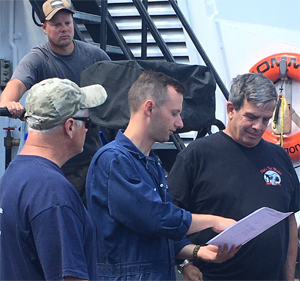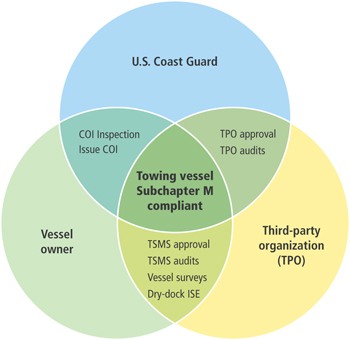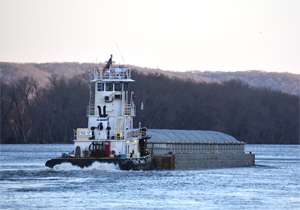Eight months into the Subchapter M certification process, many in the industry are concerned that the rollout is resulting in inconsistent interpretations of the rules, confusion on the part of operators, and a lag in vessel inspections.
“It’s a very bumpy road on the front end of this implementation process,” said Chris Parsonage, president of the Towing Vessel Inspection Bureau. “A fair amount of the blame really falls to the Coast Guard for not having the policies in place before they were implemented and still not providing proper guidance.”
Towing companies have two options to comply with Subchapter M: annual Coast Guard inspections, or the use of a towing safety management system (TSMS) approved and verified by a third-party organization (TPO). Under Subchapter M, 25 percent of a company’s fleet (vessels 26 feet in length or greater) must obtain a certificate of inspection (COI) by July 22, 2019; 50 percent by July 20, 2020; 75 percent by July 19, 2021; and 100 percent by July 19, 2022. Single-vessel owners have until July 20, 2020, to get their certificate. The COI is good for five years, although vessels must be re-inspected by the Coast Guard or re-surveyed each year by a TPO.
Parsonage said the partial government shutdown, which began on Dec. 22, will make it extremely difficult for 25 percent of towing fleets to be inspected by July 20.
“I will tell you that this (shutdown) and its impact on the Coast Guard is going to have a very negative impact on our ability to do the inspections that need to be done,” he said in early January. “It looks like most of the civilian work force has been furloughed.”
For its part, the Coast Guard said work will continue despite the shutdown. “The Coast Guard will continue to perform functions and activities to maintain the essential safety, security and environmental protection services that the public expects,” said spokeswoman Lt. Amy Midgett. “This includes functions and activities that directly support commercial vessel safety. The Coast Guard will continue to adjust its operations to support commercial vessel safety in the most timely manner possible.”
Training on Subchapter M is ongoing. Marine inspectors “receive a variety of instruction and support from leadership to ensure knowledge of the requirements under Subchapter M,” Midgett said. This includes training events for specific geographic areas, monthly conference calls with the Commercial Vessel Compliance staff at Coast Guard headquarters, and outreach meetings with the maritime industry.
 |
|
Petty Officer 1st Class Jeff Deronde, center, an inspector at Coast Guard Marine Safety Unit Portland (Ore.), presents Scott Shaver, president of Shaver Transportation, with a Subchapter M certificate of inspection for the towing vessel Sommer S. on July 20. The company used the Coast Guard option to obtain the COI. |
|
U.S. Coast Guard photo |
According to Caitlyn Stewart, director of regulatory affairs for the American Waterways Operators, her impression is that “generally, things are progressing as the industry and the Coast Guard expected. However, we are aware of instances and issues that have arisen that required resolution, and we are aware of special circumstances where there have been challenges.”
Complaints about the lack of uniform enforcement of the new rules have been raised since at least last July. However, those working with companies on inspections said the inconsistencies continue.
“Right now, I am in the 9th District,” said Bob Russo, chief executive officer at First Coast Maritime Academy in Atlantic Beach, Fla., a nonprofit organization that is training Coast Guard inspectors on Subchapter M. “How the 9th District does things is substantially different from how the 8th District does things.”
Russo said lack of consistency has come up in the requirements for electrical standards and for pilothouse alerter systems. Eric Johansson, a professor at SUNY Maritime College in Throggs Neck, N.Y., said he has been told the definition of a self-contained breathing apparatus for firefighting is incorrect in Subchapter M. He said he has found inconsistencies in the requirement for the number of engineers needed on a vessel, and he also is concerned about the requirement that vessels carry line-throwing guns. Johansson said these issues have been discussed at meetings of the Towing Safety Advisory Committee, of which he is a member.
Manning standards also have been a problem. “The level of interpretation of what proper manning is on a vessel has a lot of variables right now,” Johansson said. He said he spoke with the owner of a Great Lakes company that had three similar vessels inspected in three different ports, and each vessel had variations on its COI. “Same boat. Same operating conditions. Three different COIs,” Johansson said.
Although no two regions of the country are alike, the requirements in Subchapter M are universal, according to Midgett. However, “in some cases, the OCMI (officer in charge, marine inspection) is authorized by certain sections of the regulation to permit departures from specific requirements when special circumstances or arrangements warrant such departures, and when an equivalent level of safety can be achieved,” she said.
Despite these issues, Johansson said he is optimistic. “It’s just because everything is so new,” he said. “People still haven’t really learned how to interpret the rules correctly. It will work its way out, I am sure it will. It’s just a learning curve.”
 |
|
Owners and operators who select the towing safety management system (TSMS) option for Subchapter M compliance must complete management and vessel audits. This is done through a third-party organization or group that can perform the work of a TPO. |
|
Pat Rossi illustration |
Parsonage was less sanguine. “I think it will take several years before it all gets sorted out,” he said. “You’ve got to remember that the brownwater industry, other than their exposure to tank barges and the vessels that are inspected, is not used to this stuff.”
Parsonage also is worried about a rush of boats needing inspections before the July 20 deadline. There are about 5,500 towing vessels in the industry, and of that number, “about 3,000 or 3,500 have selected the TSMS option,” he said. “Some of the others have gone … for the Coast Guard option, but there are a whole bunch that are undeclared in any capacity. So the Coast Guard doesn’t know whether 2,000 vessels are going to show up and use that Coast Guard option that they’re going to have to deal with, or whether these late arrivals will use the TSMS option. It is a lot of uncertainty.”
Inspectors working for third-party organizations have said throughout the process that using a TPO allows for a back-and-forth with the Coast Guard on meeting specific standards, along with not needing to schedule a Coast Guard inspection.
A problem that could arise for companies choosing a Coast Guard inspection is if an inspector comes on a boat and finds a nonconformity, Russo said. “Is it a nonconformity where the Coast Guard can issue you a temporary COI? Or is it a nonconformity that will shut you down?” he said.
In addition, the clock is ticking for companies that plan to use the Coast Guard option. Operators are required to schedule a date and submit their COI application at least 90 days before the actual inspection, according to Midgett.
Another concern for towing vessel owners is whether COI inconsistencies will be considered if their vessel is involved in a casualty. Parsonage said the Coast Guard’s investigating officers have not received the same amount of training as OCMIs about the differences between Subchapter M and Subchapter C, for example. Investigating officers “are the point of the sword, so when a situation happens, if they’re going to throw it back to the Coast Guard to resolve, then they’re cutting the TPO out of it (and) that really defeats the purpose of the whole TSMS thing,” Parsonage said.
The Coast Guard is working to solve these problems. “I think (Rear) Adm. John Nadeau is focused on it, and I think he understands the problems and is trying to help implement solutions,” Parsonage said. Nadeau is the Coast Guard’s assistant commandant for prevention policy.
If the problems continue, the Coast Guard may have to provide extensions for towing operators to obtain COIs, Parsonage said. “I don’t know what they are going to do,” he said. “They will probably add some time or give some kind of variance.”

